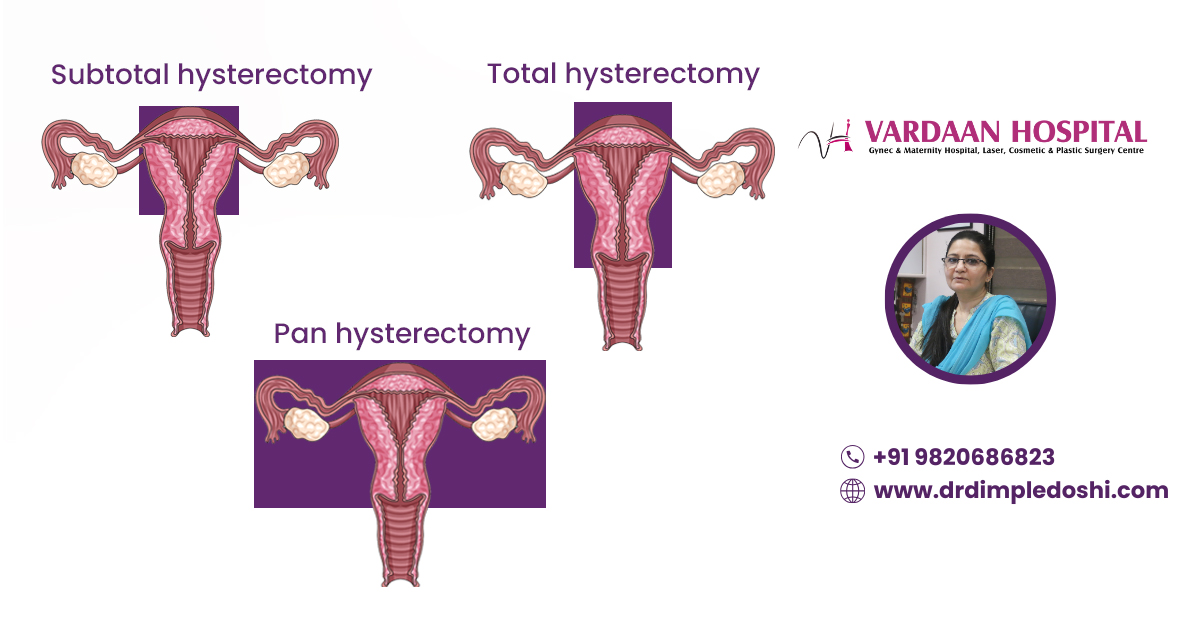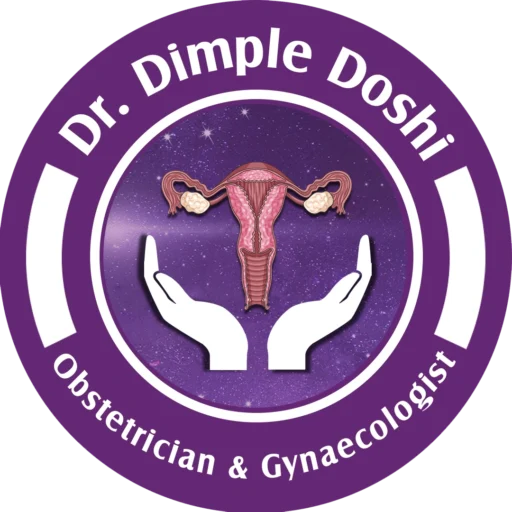Safe and Expert Hysterectomy Surgery in Goregaon West, Mumbai
 What is Hysterectomy?
What is Hysterectomy?
Hysterectomy Meaning: Hysterectomy is a surgical procedure performed to remove a woman’s uterus. After undergoing hysterectomy, a woman can no longer become pregnant and will stop having menstrual periods.
Synonyms: Uterus removal, Surgical removal of the uterus, Uterine excision, Uterine surgery,
Types of Hysterectomy Surgery?
Hysterectomy operation types include:
- Abdominal hysterectomy: Your abdomen is opened up to access the uterus and remove it.
- Vaginal hysterectomy: Uterus is removed through your vagina.
- Laparoscopic hysterectomy: Using a laparoscope, that is a thin tube for a safe uterus removal and other high-end laparoscopic instruments.
- Laparoscopy-assisted hysterectomy: Multiple stages of hysterectomy are done laparoscopically. In this method, the uterus is accessed through vagina and the vagina is closed from below.
Robotic hysterectomy: Done with the robotic system.
Interesting Myth & Fact
Myth: You cannot have a normal sex life after hysterectomy.
Fact: Many women report an improved sex life after recovery due to relief from pain and other symptoms.
Hysterectomy Procedure
Hysterectomy procedure involves
1. Preoperative Preparation
Medical evaluation is conducted like physical assessment, imaging studies, and blood tests. This helps know the patient’s health and design the best surgical procedure.
2. Surgical Approaches
- Abdominal Hysterectomy
Large incision is made in the lower abdomen along the bikini line to remove the uterus.
- Vaginal Hysterectomy
An incision made in the vagina to remove the uterus without the need for abdominal incision.
- Laparoscopic Hysterectomy
Uses a camera and surgical tools to perform an incision at the abdomen to remove the uterus.
- Robotic-Assisted Hysterectomy
Used in complex cases, under the assistance of a robotic system for more precise movements.
3. Surgical Process
- Your surgeon separates the uterus from ovaries, fallopian tubes, cervix and supporting ligaments.
- Eliminates the supply of blood vessels to the uterus.
- The uterus is carefully removed, and the incisions are closed with sutures(dissolvable threads).
Hysterectomy Complications
Most women after undergoing hysterectomy surgery revealed they had no serious problems or complications. Hysterectomy is safe when performed by an experienced gynecologist, Dr. Dimple Doshi.
However, hysterectomy surgery is considered major surgery and is not without risks. The complications may include:
- Bleeding
- Injury to surrounding structures
- Wound infections
- Blood clots
- Urinary incontinence
- Fistula or an abnormal connection between vagina and bladder
- Chronic pain
- Nerve Injury
- Reaction to Anesthesia
- Early menopause if ovaries are removed
Hysterectomy Side Effects
- Hormonal changes (if ovaries are removed)
- Changes in sexual function
- Emotional effects
- Changes in bladder or bowel function
- Fatigue and extended recovery time
- Pelvic floor weakness
What are Hysterectomy Reasons?
Common reasons for hysterectomy:
- Heavy menstrual bleeding
- Endometriosis
- Chronic pelvic pain
- Adenomyosis
- Uterine prolapse
- Cancer prevention treatment (uterine, ovarian, cervical, or endometrial)
- Complications during childbirth
- Uterine Fibroid
Hysterectomy Operation Cost
Hysterectomy surgery cost is Rs. 70,000 to Rs. 2,00,000 at Vardaan Hospital, India, Mumbai.
Hysterectomy Recovery
- Stay: After hysterectomy surgery, you can go home within 48 hours. In case of an open hysterectomy, you will be discharged after 4 days.
- Diet: Moderate diet on 1st day. Full diet from the second day.
- Mobilization: You can start to walk the same day after laparoscopic hysterectomy. In case of open and vaginal hysterectomy surgery, you can freely walk after 24 to 48 hrs instructed by your gynecologist.
- Pain: Pain with modern methods like laparoscopy is minimal. And you will be given round-the-clock pain killers to smoothen your recovery.
- Dressing: Your dressing will be waterproof.
- Bath: You can take a bath after you are discharged. However, in the hospital, you may be given a sponge bath.
- Follow-up: 6 days after your surgery is done.
Benefits of Hysterectomy
- Relief from chronic conditions like uterine fibroids, endometriosis, or abnormal bleeding.
- Cancer prevention
- Improved quality of life
- Stops menstrual periods
- Long-term fix for all your gynecological problems
Best Surgeon for Hysterectomy
Dr. Dimple Doshi is the best hysterectomy surgeon and doctor in India, Mumbai. Dr. Dimple has an extensive experience in performing hysterectomy surgery and provided great relief to women from all walks of life.
Best Hospital for Hysterectomy
Vardaan hospital in Mumbai is the best for hysterectomy surgery. The center offers top-class, latest high tech equipment aided by patient-friendly staff led by Dr. Dimple doshi
Frequently Asked Questions
Q1. How is life after hysterectomy?
Ans. You will stop having menstrual periods. Relief from pain.
Q2. Can you live normally without a uterus?
Ans. Yes, you can live a normal life without a uterus. Hysterectomy eliminates pain, discomfort, and several gynecological issues.
Q3. What is the age limit for hysterectomy?
Ans. There isn’t a particular age limit for a hysterectomy. Hysterectomy is based on medical requirements and there isn’t a particular age limit. It is more common in women over 40 years older.
Q4. Can hysterectomy cause cancer?
Ans. No, hysterectomy does not cause cancer. Hysterectomy reduces the risk of uterine, cervical cancers in many cases.
Q5. Which type of hysterectomy is safest?
Ans. Laparoscopic hysterectomy is minimally invasive and is the safest surgical procedure to remove the uterus.
Medical Code for Hysterectomy
CPT code for hysterectomy
Abdominal Hysterectomy:
58150 – Total abdominal hysterectomy (corpus and cervix), with or without removal of tube(s), with or without removal of ovary(s)
58152 – Total abdominal hysterectomy with partial removal of the vaginal cuff
Vaginal Hysterectomy:
58260 – Vaginal hysterectomy, for uterus 250 grams or less
58262 – Vaginal hysterectomy, for uterus 250 grams or less, with removal of tube(s) and/or ovary(s)
58291 – Vaginal hysterectomy with repair of enterocele
Laparoscopic Hysterectomy:
58570 – Laparoscopic total hysterectomy for uterus 250 grams or less
58571 – Laparoscopic total hysterectomy with removal of tube(s) and/or ovary(s) for uterus 250 grams or less
58573 – Laparoscopic total hysterectomy for uterus over 250 grams with removal of tube(s) and/or ovary(s)
Laparoscopically Assisted Vaginal Hysterectomy (LAVH):
58550 – Laparoscopy assisted vaginal hysterectomy, for uterus 250 grams or less
58552 – Laparoscopy assisted vaginal hysterectomy, for uterus 250 grams or less, with removal of tube(s) and/or ovary(s)
58554 – Laparoscopy assisted vaginal hysterectomy, for uterus over 250 grams, with or without removal of tube(s) and/or ovary(s)
Radical Hysterectomy (for oncology cases):
58210 – Radical abdominal hysterectomy, with bilateral total pelvic lymphadenectomy and para-aortic lymph node sampling (biopsy), with or without removal of tube(s), with or without removal of ovary(s)
58548 – Laparoscopic radical hysterectomy with pelvic lymphadenectomy and para-aortic lymph node sampling
Reference: Codify by AAPC

